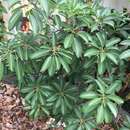fr
noms dans le fil d’Ariane


Ficus subpisocarpa (called 笔管榕 in China and 雀榕 in Taiwan) is a species of small deciduous tree native to Japan, China, Taiwan and southeast Asia to the Moluccas (Ceram).[2] Two subspecies are recognised. Terrestrial or hemiepiphytic, it reaches a height of 7 m (23 ft). Ants predominantly of the genus Crematogaster have been recorded living in stem cavities. Ficus subpisocarpa is pollinated by Platyscapa ishiiana (Agaonidae).
French botanist François Gagnepain described Ficus subpisocarpa in 1927, from a collection near Haiphong in Vietnam. It was reduced to a synonym of F. superba variety japonica by E. J. H. Corner in 1965,[3] before being raised to species status again by Cornelis Christiaan Berg in 2005. Two subspecies are recognised. Within the genus, Ficus subpisocarpa belongs in the banyan subgenus Urostigma section Urostigma subsection Urostigma.[1]
Ficus subpisocarpa is a tree that grows up to 7 metres (23 feet) high, growing from the ground or directly on other trees (hemiepiphyte). The bark is dark brown,[4] while the branches are reddish brown to dark grey.[1] The tree is deciduous.[5] The tree's leaves and petioles are glabrous (smooth), and the leaves are symmetrical, elliptical and oblong with a rounded base, and can measure anywhere from 4 to 24 cm (1.5 to 9.5 in) long by 1.5–13 cm (0.59–5.12 in) wide. They are spirally arranged on the stem.[1] The growth of new tissue occurs when a whole section of the branch undergoes budding and becomes covered with leaves. The figs are ramiflorous, that is they grow on the branches, in groups of one to three.[1] There is a high variation in color between trees and seasons; mature figs are whitish pink to dark purple, and are bulbous in shape and measure 0.5 to 0.8 cm (0.20 to 0.31 in) in diameter.[1][4] Two to four crops of figs can be produced in a year.[5]
Subspecies pubipoda is distinguished by having the base of the petiole covered in white fur.[1]
The nominate subspecies is found from Southern Japan, Taiwan, Hainan and eastern China (where it occurs in Fujian, Guangdong, Guangxi, southern Yunnan and southeastern Zhejiang provinces), through Vietnam, Laos and Thailand into Indonesia where it reaches Ceram in the Moluccas. It is possibly found in Cambodia.[1][4] Subspecies pubipoda is found in Vietnam, Cambodia, Thailand and Peninsular Malaysia.[1]
Both subspecies are found in deciduous and evergreen forests, the nominate at low altitudes and subspecies pubipoda to 1,400 m (4,600 ft).[1]
In a field study in Taiwan, ants were found to inhabit cavities within internodes of young branches of Ficus subpisocarpa.[5] They feed on wasps, more commonly on non-pollinating rather than the pollinating species necessary for the fig to reproduce. It is possible that the fig developed the cavities to accommodate the ants. 75% of ants recorded in the study belonged to the genus Crematogaster, with the remainder belonging to the genera Technomyrmex, Myrmica and Prenolepis. Sometimes two ant species shared the cavities. The cavities mostly ranged between 2 and 14 cm (1 and 5.5 in) in length. The ants appear to tend aphids and scale insects that are present on the fig plant.[5] Ficus subpisocarpa is the second Ficus species observed with ants inhabiting branch cavities, the first observation was done in Borneo on Ficus obscura var. borneensis.[6]
Ficus subpisocarpa (called 笔管榕 in China and 雀榕 in Taiwan) is a species of small deciduous tree native to Japan, China, Taiwan and southeast Asia to the Moluccas (Ceram). Two subspecies are recognised. Terrestrial or hemiepiphytic, it reaches a height of 7 m (23 ft). Ants predominantly of the genus Crematogaster have been recorded living in stem cavities. Ficus subpisocarpa is pollinated by Platyscapa ishiiana (Agaonidae).
Sộp[1] hay còn gọi đa sộp (danh pháp khoa học: Ficus subpisocarpa) là một loài thực vật có hoa trong họ Moraceae. Loài này được Gagnep. mô tả khoa học đầu tiên năm 1927.[2]
Sộp hay còn gọi đa sộp (danh pháp khoa học: Ficus subpisocarpa) là một loài thực vật có hoa trong họ Moraceae. Loài này được Gagnep. mô tả khoa học đầu tiên năm 1927.
雀榕(学名:Ficus subpisocarpa或Ficus superba var. japonica )[1],又名鳥榕、鳥屎榕、筆管榕、赤榕和山榕,英文俗名 Red Fruit Fig-tree,为桑科榕屬的一種落葉喬木 。[2]
可见于中国大陆南部、台灣、日本、琉球、東南亞等亞熱帶氣候帶。[3]。
為台灣原生植物,主要棲地為於低海拔林麓至平地。亦為普遍的園藝景觀作物。善於藉各種動物傳播種子,故分佈無特定限制。
為陽性植物,性喜温暖润湿气候,但可耐一定程度的乾旱與寒冷,易生於向陽之處。幼樹耐陰,可在林間生長。最適生育溫度約23~32°C,日照以70~100%為佳。
雀榕能夠生長在貧瘠、酸性,甚至受污染的土壤,生態環境囊括岩石縫隙間至壤土。另因其氣根發達,可以種植在大型石頭上。[4]
大型常绿乔木,具乳汁液,株高可至20-25米。多氣生根,往下生長後觸地,可形成樹幹狀的支柱根。樹幹皮灰褐色。
其葉為单叶互生,平滑無毛,呈紙质,側脈7-9對,略帶波浪狀的全緣葉。頂芽,早落而留環狀托葉痕。葉形橢圓至倒披針形,葉長10-17cm,闊4-6cm。葉紙全緣或波狀緣。葉色浓绿,但新葉紅艷嫩,苞片白至淡紅色。老叶落叶前會由绿转红,每年落叶約2-4次,使樹暫時呈光禿狀態,但此況不會維持太久,很快就會長出新的葉片。[5]
花色绿白,长在总状花序之上。秋季時結果,果實類型為隱花果,腋生或幹生,熟果褐紅到紫紅色,有斑點。雌雄同株,同一花序常混生雌花、雄花及蟲癭花。隱頭花序生長於中空的花托之中,先端有孔,內有多枚苞片。雄花少數,位於花序開口處,無柄,花被片3~4枚,雄蕊 1 枚。雌花無柄,子房平滑,花柱細長,柱頭漸尖,花被片4~5枚。蟲癭花有柄,子房平滑,球形或卵形,花柱短,花被裂片 3~4 枚。[6]
雀榕為常見的園景樹,可以遮蔭、防風沙。此外,其幼嫩托葉可食用。將其枝葉搗爛,還可以外敷治潰爛傷口。[5]
夏天時,雀榕的榕果長滿整株枝幹,十分搶眼。成熟的果實會吸引許多鳥雀,如白頭翁、綠繡眼、麻雀,或是中小型哺乳動物如赤腹松鼠、飛鼠等前來享用。動物們吃了雀榕果實,不會被消化的種子若被排遺到適宜生長處,就可以抽芽生長。這也是雀榕也被稱為鳥榕的原因。
雀榕種子適應力強,各種鳥類會經過的地方如屋頂、墻角、甚至是其他樹的樹幹縫隙都能成為雀榕生長的地點。而在其他樹幹上生長的雀榕常會造成纏勒現象,影響該樹的生長,甚至導致個體的死亡。樹幹易形成縫隙的樹木常受其害。[7]
雀榕(学名:Ficus subpisocarpa或Ficus superba var. japonica ),又名鳥榕、鳥屎榕、筆管榕、赤榕和山榕,英文俗名 Red Fruit Fig-tree,为桑科榕屬的一種落葉喬木 。